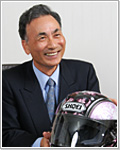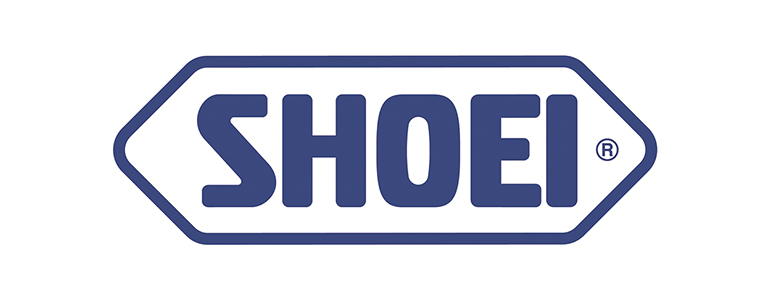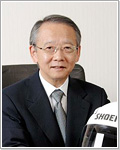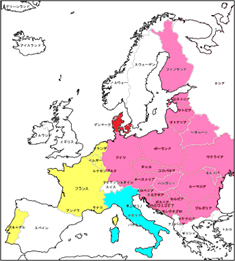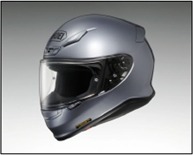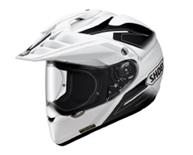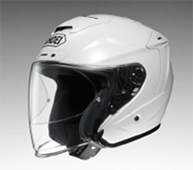| SHOEI Co., Ltd. (7839) |
|
||||||||||||||
Company |
SHOEI Co., Ltd. |
||
Code No. |
7839 |
||
Exchange |
Second Section, TSE |
||
Chairman |
Masaru Yamada |
||
President |
Hironori Yasukochi |
||
Headquarters |
Ueno 5-8-5, Taito-ku, Tokyo |
||
Year End |
September |
||
Website |
|||
* Share price as of close on December 12, 2014. Number of shares outstanding at end of the most recent quarter excluding treasury shares.
|
||||||||||||||||||||||||
|
|
* Estimates are those of the Company.
This Bridge Report discusses the fiscal year September 2014 earnings results and fiscal year September 2015 earnings estimates for SHOEI Co., Ltd.
|
|
| Key Points |
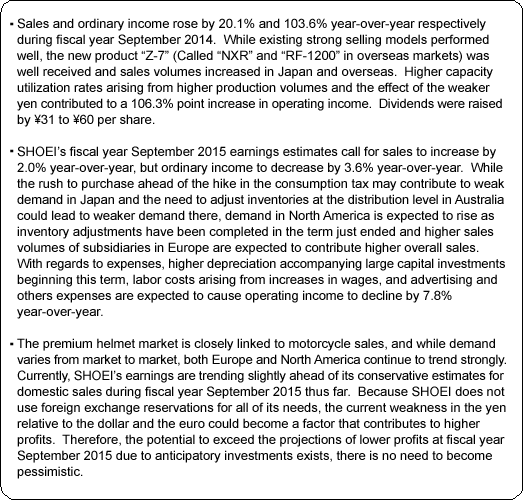 |
| Company Overview |
|
Management Policy: Achieve World's Top Levels in Three Realms
<Business Description>
Motorcycle use helmets account for about 90% of total sales. SHOEI focuses upon high value added "premium helmets" that are manufactured at its two plants in Ibaraki (Inashiki City) and Iwate (Ichinoseki City) Prefectures in Japan. The Company is able to maintain high quality levels and prevent the leakage of its technology by maintaining manufacturing facilities within Japan. In addition, SHOEI is the only helmet company in the world utilizing the "Toyota Production System" to achieve high levels of profitability, inventory turnover and asset efficiency.
<Overseas Sales Account for 75% of Total mainly in Europe>
<Corporate History>
SHOEI was established as polyester processing manufacturer in 1954. In March 1959, Shoei Kako Co., Ltd. was established as a corporation and the Company used its polyester processing technologies to enter the helmet market. In the following year of January 1960, production of helmets for motorcycle riders was started, and in July 1968 a subsidiary was established in the United States. In July 1987, entry to the French market was launched along with the establishment of a local subsidiary. However, the bursting of the economic bubble within Japan forced SHOEI to file for corporate reorganization in May 1992. In September 1992, the current Chairman Masaru Yamada, who was working at Mitsubishi Corporation, took on the task of administrator of the corporate reorganization. The reorganization plan was approved in Decmber 1993. During the reorganization process, SHOEI also entered the German market with the establishment of a German subsidiary in March 1994 made possible by the successful reorganization efforts. The reorganization efforts were successfully completed in a relatively short period of time of four years and three months in March 1998 and along with the completion of the reorganization, the Company name was changed to SHOEI Co., Ltd. in December 1998. In July 2004, SHOEI listed its shares on the JASDAQ Market, and then moved its listing to the Second Section of the Tokyo Stock Exchange in September 2007 (JASDAQ listing was eliminated at the same time). Currently, SHOEI has become recognized globally as one of the top manufacturers of premium helmets.
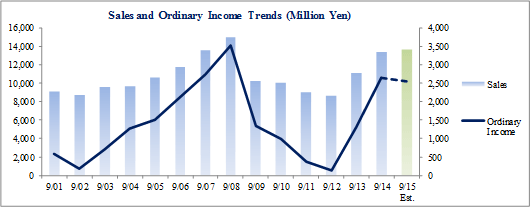 <Maintaining Basic Policy for Medium and Long Term Stable Growth and Stable Profit>
(1) Protect Own Company by Ourselves
(2) Made in Japan and maintaining constant employment (Transmission of Manufacturing)
(3) Maintain healthy financial positions
(4) Continuation of Investments (Development of new products, Cost saving, Improvemnet of quality, Firm safety)
(5) Targeting #1 in All Premium Helmet Markets in the World
(6) Development of New Markets and Deepening of Existing Markets
(7) Fair distribution of retained earnings (50% dividend of profit after tax, distribution to employees and distribution to company (proper retained earnings kept)
 <New Product in 2014 - NXR (Europe)/RF-1200 (North America) / Z-7 (Japan) ->
During the past three years to 2013, SHOEI introduced new products including "GT-Air," "J-Cruise," and "NEOTEC"(they are all Japanese name), which have visors for touring use applications, to respond to the various needs of riders from sports riding to touring applications. Responding to requests from sports bike riding fans, lightweight, compact and sporty full-face helmet "NXR/RF-1200/Z-7" was introduced in 2014.
<New Products in Introduced in 2015 - HORNET ADV (Europe, Japan) /
HORNET is a premium sports utility helmet that pursues safety and comfort and is designed with adventure biking needs in mind.
HORNET X2 (North America,) J-Force IV (Japan)> HORNET ADV (Europe, Japan) / HORNET X2 (North America)
J-Force IV (Japan)
"J-Force IV" represents a comprehensive evolution of the J-Force III product and is the newest addition to this lineup of premium open face "J-Force" helmets. It offers improvements from the base concept of "lightweight, compact and effective ventilation," having PINLOCK® EVO lens ensures clear vision and pursues sporty form and anti-fog capability to enhance driving safety.
|
| Fiscal Year September 2014 Earnings Results |
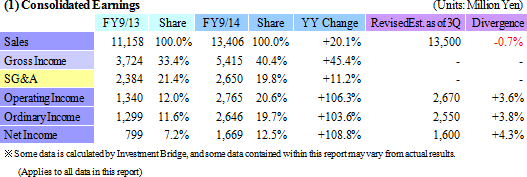 Premium Helmets Sales Volume Rose in All Regions Excluding North America, Market Share Also Rose
The premium helmet market (High quality and value addition motorcycle use helmets) is closely linked to motorcycle sales. Motorcycle sales within Japan have continued to increase during the past three consecutive terms, and a recovery from previously stagnant European market has also been noted. The markets in the United States and Canada appear to have bottomed. Amidst these trends, SHOEI's existing top selling models "GT-Air," "J-Cruise," and "NEOTEC" recorded strong sales, and new products introduced during the current term including "Z-7" (Also called "NXR" and "RF-1200" in overseas markets) has been well received and sales volumes increased in both Japan and overseas. SHOEI's share of the premium helmets market increased.Consequently, sales rose by 20.1% year-over-year to ¥13.406 billion. Higher capacity utilization rates arising from increases in production volumes and the effect of the weaker yen contributed (deduction in ordinary income base ¥429 million leverage effect) to a 7.0% point improvement in cost of sales ratio to 59.6% and a 45.4% year-over-year increase in gross income. Operating income also rose by 106.3% year-over-year to ¥2.765 billion due to the ability to absorb increases in sales, general and administrative expenses. While non-operating expenses increased due a rise in foreign exchange translation loss on reservations (Rose from ¥35 million to ¥117 million), net income rose by 108.8% year-over-year to ¥1.669 billion due to decreases in tax rates. During the term, the average foreign exchange rates were ¥102.96 to US dollar (¥8.43 weakening) and ¥139.34 to euro (¥17.12 weakening). 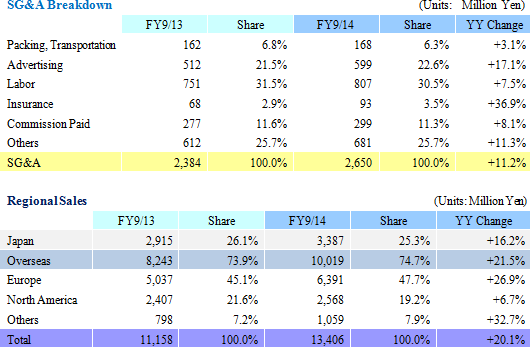 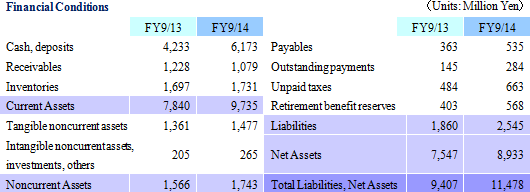 Cash and deposits accounted for about 54% of total assets. The current ratio, which is identified as "short-term solvency safety line" of 100%, stood at 501%, and noncurrent ratio, which is identified as "safe at levels for a long term below 100%", stood at 19.2%. Rate of return on invested capital, indicating how efficiently capital is used to generate profits, increased to 30.4% in the current term from 17.1% in the previous term. Equity ratio stood at 77.8%.  |
| Fiscal Year September 2015 Earnings Estimates |
 Sales Expected to Rise by 2.0 %, Ordinary Income to Decline by 3.6%
SHOEI's earnings estimates call for sales to rise by 2.0% year-over-year to ¥13.680 billion. In North America, growth in sales volumes and the positive influence of a weaker yen is expected to contribute to an increase in sales of 14.5% year-over-year. In Europe, increases in sales of subsidiaries, which account for 70% of total sales in Europe (Sales volumes of agents are expected to decline), are expected to allow overall sales to grow by 3.7% year-over-year. At the same time, lower sales volumes arising from the disappearance of the rush to purchase ahead of the hike in the consumption tax are expected to contribute to a decline in sales within Japan of 7.3% year-over-year. Furthermore, adjustment of inventories in Australia is expected to contribute to a decline in sales of other regions of 8.4% year-over-year. With regards to profits, increases in depreciation due to the start of large capital investments during the coming term, higher personnel expenses due to hikes in wages, and higher advertising expenses are expected to boost overall expenses and contribute to a 7.8% year-over-year decline in operating income to ¥2.550 billion. While SHOEI's estimates do not include the influence of foreign exchange, improvements in tax rates affecting subsidiaries in Europe are expected to allow net income to remain in line with the previous year's levels at ¥1.670 billion.Capital investment is expected to reach ¥1.038 billion (¥525 million in previous term) and depreciation ¥550 million (¥397 million in previous term). SHOEI's foreign exchange rate assumptions are ¥108.0 to the US dollar (a ¥5.04 weakening compared to previous term), and ¥138.0 per euro (a ¥1.34 strengthening). About 50% and 75% of the US dollar and euro currency needs, respectively, have been booked using foreign exchange reservations at ¥108 to the US dollar and ¥137 to the euro. The impact of fluctuations in foreign exchange rates of ¥1 result in changes in profits of ¥10 million relative to the dollar and ¥14 million relative to the euro.  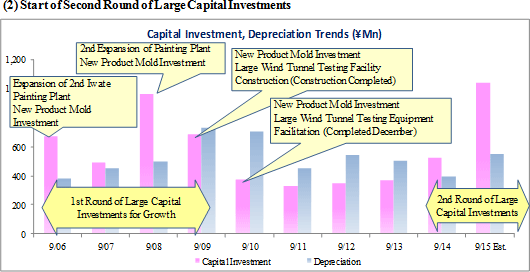 First Round of Large Capital Investments Support the Current SHOEI
SHOEI conducted its first round of large capital investments for growth during the terms covering fiscal year September 2006 to 2009. Amongst the most notable investments made was the construction of a large wind tunnel testing facility (Wind tunnel facility and equipment). This wind tunnel enables SHOEI to make sustained introduction of new products (According to President Yasukouchi, this investment is a driver of SHOEI's current earnings), and contributes to differentiation with their competitors.Thereafter, SHOEI has focused its investments upon new product molds in light of the deterioration in its operating environment (SHOEI has made a commitment to introducing at least one new product every term). Due to the improvement in the operating environment and the investment capability for business expansion, the Company has decided to launch the second round of large capital investments starting from fiscal year September 2014. Second Round of Large Capital Investments to Realize Stable Management over the Long Term
The second round of investments is designed to achieve results in the form of stable management over the long term, and includes investments for new products (molds and dies), improvements in manufacturing efficiencies (Laser processing equipment renewal, automatic materials processing machinery fortification, painting facility renewal, new forming machinery development and introduction), crisis management (Air conditioning facility renewal and fortification, electric power facility fortification, factory building renewal, safety and environmental improvement investments), and companywide management systems (IT) for societal operation improvement and rationalization. Consequently, total investments are expected to reach ¥4.0 billion over a five year period from fiscal year September 2015 (For an annual rate of ¥0.7 to ¥0.8 billion per year in capital investments). Moreover, capital investments in fiscal year September 2015 alone are expected to amount to ¥1.038 billion. However, with operating cash flow of ¥2.084 billion anticipated, free cash flow of ¥1.046 billion is expected to be achieved even after this large capital investment is conducted.
(3) Yearend Dividend of ¥60 Per Share Expected
SHOEI views the return of profits to shareholders as a key management issue, and maintains a basic policy of "distribution of profits in line with earnings performance" that focuses upon dividend payout ratio as a guideline. Based upon this policy, SHOEI will fortify its financial and management foundations while at the same time strengthening its shareholder equity. Furthermore, it will endeavor to pay a term end dividend that is equivalent to a dividend payout ratio of 50% (Currently, dividends are only paid at the yearend). In keeping with the above policy, yearend dividend payment in fiscal year September 2015 is expected to be ¥60 per share.
|
| Conclusions |
|
While there is significant variance in the rate of growth in most of the major global motorcycle markets, sales volumes in most markets are on the rise including 2.8%, 3.5%, 10.5%, 11.0%, 3.1%, 13.0%, 3.7% and 18.9% increases in the United States (6/14), Canada (9/14), Japan (7/14), Germany (10/14), France (10/14), the United Kingdom (10/14), Italy (10/14), and Spain (10/14) respectively. Generally speaking, the market is getting stable thinking of the increase in Italy and Spain.Furthermore, sales within Japan are trending slightly ahead of SHOEI's conservative estimates for fiscal year September 2015. Given that foreign exchange reservations have not been booked for all of the Company's needs, the current weakness in the yen relative to the dollar and euro can be expected to boost profits a step further. Therefore, the potential to exceed the estimates of lower profits due to anticipatory investments exists. Moreover, SHOEI was able to beat out its German competitors and acquire top ranking in a survey (Ranking of the most widely recognized helmet brands) conducted by a German sports helmet magazine. Also in the United States, the SHOEI brand was also able to hold off its American competitors and acquire top ranking (Which brand of helmet owned) in an off road helmet magazine survey. The fact that SHOEI was able to take top spot in an ownership ranking of off road helmets, which are generally cheaper in price than SHOEI's products, is a significant feat and reflects the strong brand reputation for quality and safety of SHOEI helmets. Disclaimer
This report is intended solely for information purposes, and is not intended as a solicitation to invest in the shares of this company. The information and opinions contained within this report are based on data made publicly available by the Company, and comes from sources that we judge to be reliable. However we cannot guarantee the accuracy or completeness of the data. This report is not a guarantee of the accuracy, completeness or validity of said information and or opinions, nor do we bear any responsibility for the same. All rights pertaining to this report belong to Investment Bridge Co., Ltd., which may change the contents thereof at any time without prior notice. All investment decisions are the responsibility of the individual and should be made only after proper consideration.Copyright(C) 2015 Investment Bridge Co., Ltd. All Rights Reserved. |

